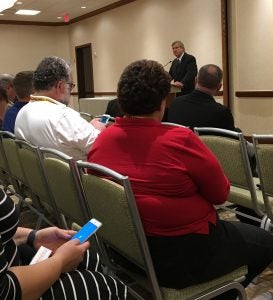When President Barack Obama told U.S. Secretary of Agriculture Tom Vilsack Wednesday evening to ask himself if he was leaving the USDA better than when got it, Vilsack could only respond with a yes.
The USDA leader reflected on his last eight years in office on Thursday afternoon at the National Association of Farm Broadcasting 73rd annual convention in Kansas City, and when he was done there were few dry eyes left in the room.
“This is a great country… this is a great country. You know I started out in an orphanage and I was in the White House last night. I have had the chance to meet and talk to five Presidents. What country does a kid start out in an orphanage and have that kind of experience?” Vilsack asked. “All of us need to step back from the hub bub and follow all of this and remember that, and be thankful for that and look for big and small ways to help.”

The 65-year-old dedicated serviceman listed several ways the USDA has improved during his tenure: civil rights cases that were pending for decades are now settled, the agency is more diverse, the workforce is reflective of the people they serve, the IT system has been modernized, and there have been record investments in the basic infrastructure programs and ways to leverage dollars.
His only regret is not getting that story out into mainstream national media or what he refers to as ‘legacy’ media.
“We have had a hard time convincing those folks in that legacy media to pay enough of the kind of attention this part of America deserves,” Vilsack said.
When the President challenged Vilsack to think about his last eight years and if the USDA and rural areas are better, the Secretary of Agriculture determined he could make the case through these five points:
Farm Credit
In the past eight years, the Farm Service Agency has given out almost 280,000 loans, lending out $40 billion. They have expanded opportunities to serve under-served producers, established a new microloan program, developed IT programs to make it easier for producers to access records and more convenient ways to do business with local offices.
Risk Management
There are common reporting dates now between FSA and RMA. They have streamlined the info and data collection process. The department has provided a degree of assistance and lower premium costs for beginning farmers and ranchers. Supplemental coverage is now available for 59 crops. The USDA has expanded opportunities for organic and specialty crop producers – in 2009, there was only coverage for four products, today 57 are covered. The Whole-Farm Revenue Protection program is now available in every single county in the U.S.
Conservation
A record number of acres have been enrolled. Working Land for Wildlife, a partnership between the Natural Resources Conservation Service and the U.S. Fish and Wildlife Service, has provided landowners technical and financial assistance to restore the habitat for species on their land. Over 200 projects have been funded- doubling amount of money in that program available for conservation
The department has focused on innovation from drought strategies to the development of ecosystems markets. A total 414 grants were awarded to producers with $173 million going back into rural economy. The USDA has doubled the number of operators in this country utilizing the benefit of renewable energy
Safety Net
ARC and PLC program now available to 1.7 million farming operations — this is more participation than the direct payment program. The department streamlined the disaster declaration process so they could get emergency loans more readily available to those hit by disasters … 19 states, 150 counties are currently benefiting from it.
Market Perspective
The international market efforts have been historic and record breaking. Vilsack said for the first time in any eight-year period in the history of the country, the U.S. has exceeded a trillion dollars in agricultural exports. The USDA opened beef trade in 16 countries that had restricted beef trade previously because of BSE. The department has focused on the expansion of local and regional food systems, invested in bio-based economy, and been a strong supporter of value-added propositions.
“If that’s the test I think we can make the case that It’s been an interesting, historic, record-breaking eight years,” Vilsack said. “I’m in the process of finalizing a little memo that I will provide to my successor and it starts with making sure that he or she understands what an incredible opportunity they are going to have, how lucky and fortunate they are to be in charge of this department because there are just incredible committed folks to working in the missionaries every day.”



